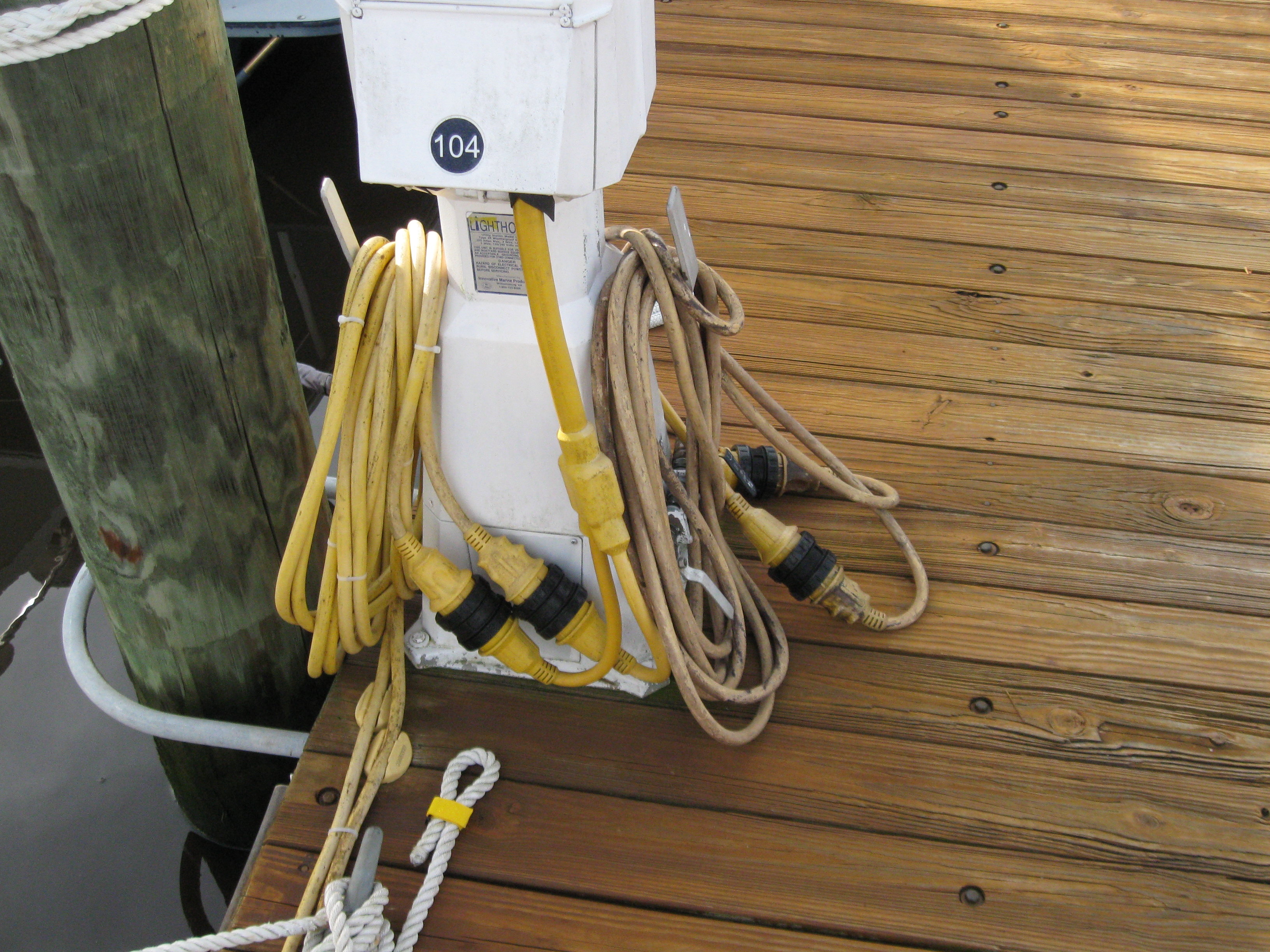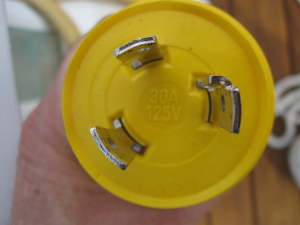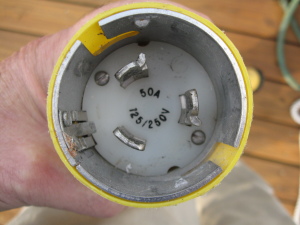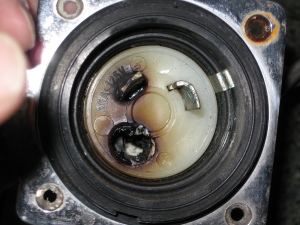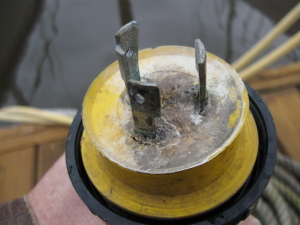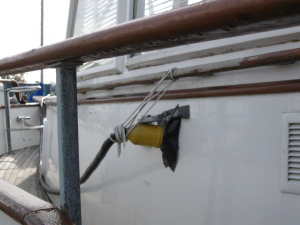By Capt. Wayne Canning, AMS
Today’s boats are more comfortable and filled with shore side amenities than ever before. We like our Air conditioning TVs and microwave ovens. Nothing wrong with that. But as we place more electrical demands on our boats we also place a greater demand on our shore cords. Most of us just plug in and forget about it till something goes wrong. Taking a little extra time every now and then to inspect and maintain our shore cords can save problems and may protect you from hidden dangers.
Most cords come in 2 basic types the 125 VAC 30 AMP cord and the 250 VAC 50 AMP cord. Larger boats with heavier electrical loads and more complicated electrical systems tend to use 250 volts with a single 50 AMP cord. Most midsized boats will use 1 or 2, 125 volt 30 AMP cords depending on the loads. Regardless of the voltage or size the cords are constructed of special wire designed to withstand the rigors of the marine environment. Your cord should be yellow or white in color and be UL approved for marine use. If it is any other color it is likely not a marine cord and should be replaced. Cord lengths vary but standard is 50 foot. Some lager yachts may also have cords on powered reels that wind the cord into a bucket stowed below decks. These cords are permanently wired to the boat and make for easy stowage but require special care as the power reel can damage the cord.
According to recent posts made on Toolerant, 4% of all boat fires are a result of shore power. Although this may not seem like a high percentage it is an easily preventable problem. Most problems arise from the cord ends and not the cord itself. I have found that almost half the boats I survey have some degree damaged or improperly installed cord ends. It only takes a few minutes to properly inspect your cord and ends and should be done at least a couple of times a year.
Doing a quick visual inspection of your shore cord is not hard and is a good way to located trouble before it happens. Before you start it is best to de-energize your cord and system. Whenever plugging in your boat or unplugging it is best to follow some simple steps for safety. First turn off all power on your boat. It is better to turn off components individually then the main breaker. (If you have a generator running you can transfer power over to that and re-apply loads.) Once the ships power is down you can turn the power off on the dock. While on the dock you can unplug from the shore pedestal. Lastly disconnect from the boat. Follow this procedure in reverse for connecting your boat to shore power.
Now that you are unplugged and disconnected from power you can do a visual inspection for chafing, cuts or cracks in the cover and any other damage such as stretching. Make sure the cord does not have splices as these are a serious safety problem. If your cord has been spliced it should be replaced. Once you are sure the cord itself is serviceable you need to inspect the ends. This is where you are likely to find the most problems. Make sure if the ends are not the original molded ends that they are marine type and have properly fitted covers and lock rings. Most people overlook the lock rings or do not bother to use them. This is a mistake and can shorten the life of your cord ends. Not using the lock rings allows moisture into the connection and puts strain on the connecting pins that they were not designed for. Next look at the prongs and contacts for signs of burning or heat damage; these are signs of other problems. Check your boats inlet fittings for heat damage and burning as well. If you see any it is a sign of problems and should be corrected as soon as possible. Once a connection gets some resistance it begins to heat up, the problem is more heat results in more resistance and in turn more heat and so on till the breaker trips if you are lucky. If you are not lucky a fire can start. It takes a surprisingly little amount of current to start a fire if conditions are right.
If the cord is old or in bad shape and you find problems you might want to just replace it. 30 AMP cords are not that expensive and in many cases the cost to repair properly is simply not worth it. 50 AMP cords can be more expensive and may well be worth repairing but only if the cord itself is in good condition and the problem is just a bad end. With the rising cost of wire you will just have to evaluate the parts and labor vers simply replacing. If the cord has had a replacement end fitted it is a good idea to check the polarity of the cord. You can do this with the cord unplugged and using a Volt ohm meter to check the continuity of each contact making sure they are the same on both ends. You can also use a 3 light tester if you have a 30 AMP to 15 Amp adaptor. With the adaptor plugged in and the 3 light tester plugged in, plug the cord in and observe the indicator to verify the cord is correct. Before performing this test and several others we will get to, it would be a good idea to verify that your power source is good. Using your 3 light tester plugged into the adaptor, plug the adaptor into the power source you use on the dock power pedestal. If a fault shows try a different location. If you have faults and are sure your adapter is good report the problem to your dock master and do not plug in your boat till the problem is corrected.
If you do find your cord end has burnt or over heated ends you may want to find the cause before you replace the cord. I have heard owners complain that the new cord suffered damage shortly after replacement. The most common cause is simply overloading the cord. This is very common on older boats that have more equipment added to the boat without upgrading the shore power system or cord. Two pieces of equipment that often cause overloading are air conditioning and heating units and inverters. Time and again I have found burnt cord ends on a boat with a retro fitted AC unit on a single 30 amp cord. The owner argues that the current draw for the AC unit is only 16 amps therefore should not be any problem. True but take into account the 1500 watt water heater and you are at 26 Amps at 125 volts. Pretty close to the limit without things like battery charger. Now drop the voltage to 110 and you are at 29.5 amps, of course as the amp draw goes up the voltage will continue to drop till something gives. Often a balance is reached just at the point your cord end begins to slowly melt. And this does not take into account the start up loads of the AC compressor. Likewise many underestimate the loads an inverter/charger will place on an AC system. It is not unusual for an inverter/charger to recharge the batteries at a rate of 200 amps. This would be a load of 20 amps at 120 volts on your 30 amp cord, and once again it is not counting any other loads present. So if you find your cord end is showing signs of burning it might be time to evaluate your loads and consider adding a second 30 amp shore cord to help spread the loads.
Finally be careful how your cord is run along the boat and dock. Make sure there is plenty of slack in the cord and that it will not pull on either end as the boat moves. I recommend you take at least one wrap around the dock pedestal before plugging in there. Secure the cord to the boat in some manner before plugging it into the boat. Use the lock ring on both ends if possible and make sure the cord will not sag down into the water. Also make sure the cord is not a tripping hazard to anyone on the boat or dock. I like to secure mine to the lifelines with Velcro straps to keep it off the deck, and then secure it to one of the dock lines to keep it out of the water.
Don’t wait till problems occur. Take the time to inspect you shore cords and their ends on a regular basis to avoid problems. Take a quick look at the ends and fittings every time you plug in. If you see problems, be proactive to fix them before they get worse. If you have ends showing signs of heating reduce your load and take steps to fix the problem. If you are not sure about your loads consult a qualified marine electrician for advice. Use the cords lock rings and run the cord so that it is out of the water and harm’s way and will not be a tripping hazard. Avoid problems before they occur.
Capt. Wayne Canning, AMS
Your comments and suggestions are always welcome and encouraged so please do not be shy.
Please share and subscribe.
